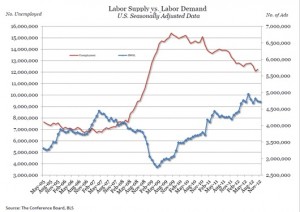 Improvements in consumer’s confidence about the economy slowed last month, as the leading indices were up, but only slightly from October.
Improvements in consumer’s confidence about the economy slowed last month, as the leading indices were up, but only slightly from October.
The Conference Board’s Consumer Confidence Index came in at 73.7 in November. Though it rose only .6 from October’s 73.1., the Index still is the highest it’s been since Feb. 2008, when it registered 76.4.
Likewise, the other major measure of consumer sentiment, Thomson Reuters/University of Michigan Surveys of Consumers, is at 82.7, a mere .1 above October’s 82.6.
Today, the Institute for Supply Management said its index of manufacturing conditions fell to 49.5, down from October’s 51.7. It’s the lowest level since July 2009. The report pushed stocks down, and, despite some positive news from the homebuilding industry and a rebound in auto sales, helped set a cautious tone for the week. The first week of each month is when a number of important reports and indices are released, capped on Friday by the monthly employment numbers from the U.S. Department of Labor.
The Surveys of Consumers’ Chief Economist, Richard Curtin, blamed uncertainty about the fiscal cliff and Congress’ ability to reach a deal. “The gains in confidence ended in late November as consumers became more uncertain about when and how
the fiscal cliff with be bridged,” he wrote.
Even so, the Reuters/UofM measure is at its highest level in five years, with consumers telling the pollsters their household income has grown, and they see a much better employment picture ahead. “The survey recorded the most favorable outlook for the unemployment rate since 1984,” said the survey report, which, nonetheless, was entitled, “Will the Congressional Grinch Steal Christmas.”
The Conference Board’s survey also found consumers more optimistic about the job market, Said Lynn Franco, director of economic indicators, “Over the past few months, consumers have grown increasingly more upbeat about the current and expected state of the job market, and this turnaround in sentiment is helping to boost confidence.”
However, this morning, The Conference Board reported that its monthly survey of jobs posted online showed new jobs declined for the fourth month out of the last five. Total jobs online during November were 4.72 million; 2.98 million were new during the month.
Since the first of the year, the monthly count of online job postings has risen by 336,505 jobs. That’s a significant improvement over the same period last year, when for the 11 months online jobs rose only 20,192. That comparison, though, is a bit misleading. This year’s increase in job postings came almost entirely in the first six months of the year. Between January and June, online postings grew by 331,411. In the next five months, the increase was just under 5,100.
The Conference Board attributed much of November’s decline in jobs listings to the impact of Hurricane Sandy.
“Hurricane Sandy pushed the national labor demand into negative territory as declines along the East Coast more than offset the gains in States in the central and western U.S,” said June Shelp, vice president at The Conference Board.
 In addition to providing a gross count of the online job listings, The Conference Board’s survey — conducted by Wanted Analytics — breaks down them down by state, region, and industry. The Conference Board also computes a labor supply ratio, comparing unemployment numbers in each state to the total number of help wanted ads posted by employers there.
In addition to providing a gross count of the online job listings, The Conference Board’s survey — conducted by Wanted Analytics — breaks down them down by state, region, and industry. The Conference Board also computes a labor supply ratio, comparing unemployment numbers in each state to the total number of help wanted ads posted by employers there.
Reports The Conference Board: “The number of advertised vacancies exceeded the number of unemployed only in North Dakota, where the Supply/Demand rate was 0.67. The State with the highest Supply/Demand rate is Mississippi (5.18), where there were over five unemployed workers for every online advertised vacancy. Note that the Supply/Demand rate only provides a measure of relative tightness of the individual State labor markets and does not suggest that the occupations of the unemployed directly align with the occupations of the advertised vacancies.”
Coming up this week:
- Wednesday: The ADP National Employment Report is released providing a count of new, private sector jobs created in November. One investment site predicts it will show about 140,000 new jobs during the month.
- Thursday: SHRM releases it monthly LINE report, predicting the recruiting and hiring outlook for December.
- Friday: The much watched monthly employment report from the U.S. Department of Labor will be released. New job growth is expected to be down in November, with much of the blame going to Hurricane Sandy. Dow Jones Newswires expects new jobs to come in around 98,000, with no change in the 7.9 percent unemployment rate. A Bloomberg News survey of economists is in the same range, forecasting an average of 90,000 jobs created in November.